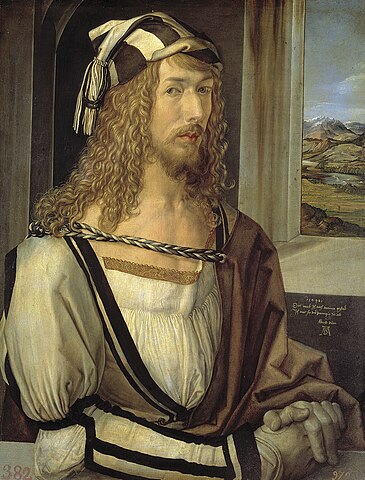
Born: 21 May 1471, Nuremburg
Died: 6 April 1528 (aged 56)
Period: High Renaissance
The Life of Albrecht Dürer
Albrecht Dürer, born on May 21, 1471, in Nuremberg, Germany, is hailed as one of the foremost artists of the Renaissance in Northern Europe. His contributions to painting, printmaking, and theory of art have left an indelible mark on the history of art, showcasing a unique blend of technical mastery, intellectual depth, and innovative thinking.
Dürer’s early years were spent in Nuremberg, where his father, a Hungarian goldsmith, provided his first artistic training. At the age of fifteen, he was apprenticed to the painter Michael Wolgemut, where he learned the basics of painting and woodcut design. This early exposure to the art of printmaking would prove to be pivotal in Dürer’s career.
After completing his apprenticeship, Dürer traveled extensively across Europe, including Italy, where he was profoundly influenced by the Italian Renaissance. He studied the works of leading Italian artists, such as Andrea Mantegna and Giovanni Bellini, and was introduced to the principles of perspective, proportion, and human anatomy. These experiences enriched Dürer’s artistic vocabulary, enabling him to fuse the detailed realism of Northern art with the idealized forms and spatial compositions of the Italian Renaissance.
Upon returning to Nuremberg, Dürer established his own workshop and began producing a series of woodcuts, engravings, and paintings that would bring him fame and financial success. His masterful engravings, such as “Melencolia I,” “Knight, Death, and the Devil,” and “Saint Jerome in His Study,” are celebrated for their intricate detail, technical precision, and deep symbolic content. Dürer’s skill in printmaking not only elevated the medium to new heights but also allowed his work to be widely disseminated throughout Europe.
Dürer’s contributions were not limited to his artworks; he was also an accomplished theorist. His treatises on geometry, human proportions, and fortifications were highly influential, reflecting his belief in the unity of art and science. His theoretical works underscored the importance of mathematical principles in artistic creation, influencing generations of artists and thinkers.
Throughout his career, Dürer enjoyed the patronage of prominent figures, including Holy Roman Emperor Maximilian I and his successor, Charles V, which allowed him to work on a variety of prestigious projects. Despite this success, Dürer remained deeply engaged in intellectual and theological debates of his time, reflecting the turbulent religious and social changes occurring in Europe.
Albrecht Dürer passed away on April 6, 1528, in Nuremberg. His legacy is vast, encompassing groundbreaking artworks, influential theoretical writings, and a profound impact on the development of the Renaissance in Northern Europe. Dürer’s work continues to be celebrated for its beauty, complexity, and innovation, securing his place as a pivotal figure in the history of art.
Albrecht Dürer’s Notable Works
Albrecht Dürer, a German Renaissance artist, is renowned for his contributions to painting, printmaking, and theory of art. Dürer’s works are celebrated for their incredible detail, innovative techniques, and the depth of emotion and intellect they convey. Here are ten of Dürer’s most famous works, which showcase his mastery across various mediums:
- “Melencolia I” (1514) – This engraving is one of Dürer’s master prints and is known for its intricate detail and complex iconography. It depicts a melancholic figure surrounded by various symbolic objects, and its meaning has been the subject of much scholarly debate.
- “The Knight, Death, and the Devil” (1513) – Another of his master prints, this engraving shows a knight riding through a dangerous landscape, flanked by the figures of Death and the Devil. It is often interpreted as an embodiment of the Christian knight’s perseverance through life’s trials.
- “Saint Jerome in His Study” (1514) – The third of Dürer’s master prints, this engraving portrays Saint Jerome working in a sunlit, well-ordered study, symbolizing contemplative life. The attention to detail in the furnishings and the use of light are remarkable.
- “Adam and Eve” (1504) – This engraving is famed for its depiction of the biblical first humans in an idealized form, showcasing Dürer’s study of human anatomy and proportion, influenced by Italian Renaissance art.
- “Self-Portrait at Twenty-Eight” (1500) – Known as one of the earliest examples of a frontal self-portrait, this painting is often noted for its resemblance to depictions of Christ. It demonstrates Dürer’s skill in oil painting and his deep self-awareness.
- “The Four Apostles” (1526) – This pair of panel paintings was a gift to the city of Nuremberg. The works depict John, Peter, Mark, and Paul, and are filled with symbolic detail reflecting Dürer’s Protestant beliefs.
- “The Rhinoceros” (1515) – This woodcut print of a rhinoceros was based on written descriptions and a sketch of an Indian rhinoceros that had arrived in Lisbon. Despite never having seen the animal himself, Dürer’s depiction became very popular and was widely circulated.
- “The Apocalypse” (1498) – This series of woodcuts illustrates scenes from the Book of Revelation. It was revolutionary for its format and is considered one of the first “artist’s books,” created and published by Dürer himself.
- “Praying Hands” (c. 1508) – Also known as “Study of the Hands of an Apostle,” this pen-and-ink drawing is a study for an apostle’s hands in the Heller altarpiece. It has become an iconic image of devotion and humility.
- “Young Hare” (1502) – This watercolor and bodycolor painting is celebrated for its detailed and lifelike portrayal of a hare, showcasing Dürer’s keen observation of nature.